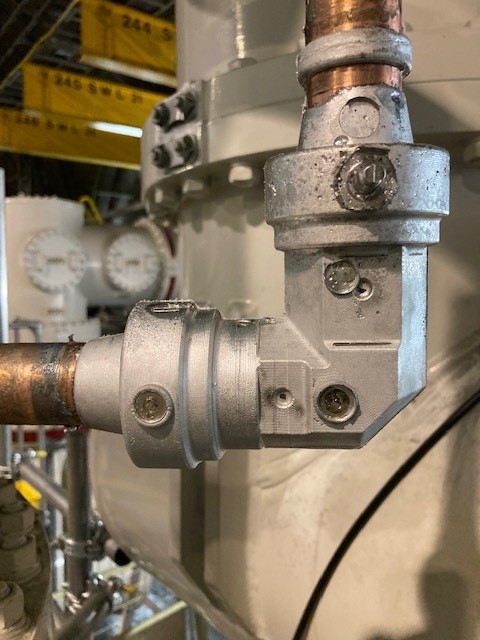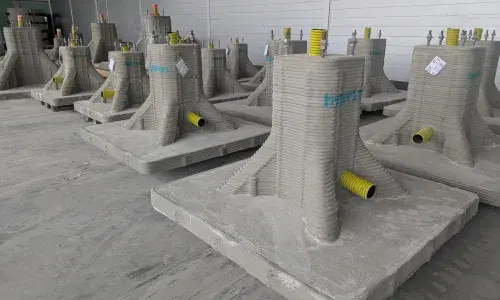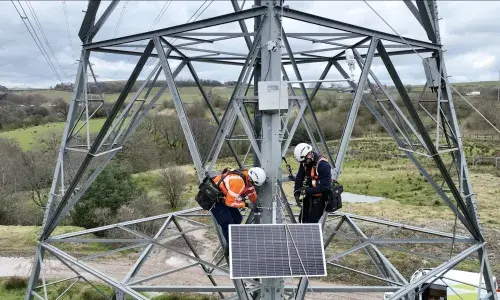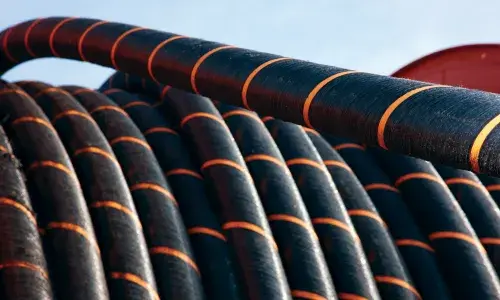
Novel anti-leak tech helps to keep National Grid substations in service during SF6 repairs
-
Rawwater’s innovative molten metal technology targets leaks of greenhouse gas SF6
-
Easy-to-deploy solution means key grid infrastructure avoids need for outages
-
New tech successfully used for repairs at Dinorwig and Sizewell substations
-
National Grid is aiming to eliminate SF6 from its infrastructure by 2050
A novel technology developed through an innovation scheme is helping National Grid fix leaks of greenhouse gas SF6 while keeping its substations safely in service.
Engineering technology company Rawwater has worked with National Grid to deploy its M3 Molten Metal Manipulation technology, which can be used to seal flowing leaks – a fix that has previously required a planned outage.
Sulphur hexafluoride (SF6) is an insulating gas commonly used in high voltage electricity equipment to prevent short circuits and to keep networks safe and reliable.
While SF6 infrastructure is designed to be effectively sealed, small leaks do occur as equipment ages – and it often requires an outage for the gas to be removed, the repairs carried out and the gas refilled again.
It's helping us reduce SF6 leaks while keeping our infrastructure in service – a double benefit for consumers as we reduce environmental impact and keep electricity flowing
Rawwater’s novel ‘M3CollarCast’ solution involves easy application of a mould to leaking pipework, into which a low-melting point liquid alloy is injected. The seal requires no curing time once solidified, so it can be applied to equipment that is in service.
Following an initial pilot trial at National Grid’s Deeside Centre for Innovation, and further studies at Cardiff University, Rawwater’s technology has been successfully rolled out in the field at Dinorwig and Sizewell substations – meaning that while leak repairs took place, power could continue flowing to the grid from two of the country’s largest hydroelectric and nuclear plants.
The new technology was initially developed as part of a Network Innovation Competition (NIC) project and is being further developed as an innovation project through the Network Innovation Allowance (NIA).
Work through the initial Deeside project, jointly funded by NIC and Rawwater, focused on testing and confirming the viability of the technology to seal SF6 under pressure in the lab, and demonstrating it was both deployable and removable on high-voltage electrical infrastructure.
The M3CollarCast achieved an average leak rate reduction of 98% when sealing against a 7 barg flowing leak in tests, indicating it was almost ready for real world application.
Under the subsequent NIA project, further testing took place with the support of Cardiff University to ensure that no metal makes its way into the equipment during repairs.
Once results showed no change to the electrical performance or gas composition of equipment due to the repair, the technology was rolled out at Dinorwig, and subsequently at Sizewell. National Grid is also exploring using the technology for repairs at its Stella West substation.
Nicola Todd, head of strategy and innovation at National Grid Electricity Transmission, said: “SF6 is a potent greenhouse gas with a global warming potential many thousand times greater than CO2, and it’s a significant contributor to our company’s climate footprint.
“We have a programme of work underway to reduce our dependency on SF6 technology in England and Wales, but initiatives like this innovation project with Rawwater are critical in mitigating its impact in the meantime.
“This clever and cutting-edge new technology is helping us reduce SF6 leaks while keeping our critical infrastructure in service, reducing the need for outages. That’s a double benefit for consumers as we reduce environmental impact and keep electricity flowing around the country.”
Kat Lennox, managing director of Rawwater Applied Technology, said: “Even though the phase-out of SF6 is planned around the world, it will be many years before this highly insulating greenhouse gas is eradicated completely from electricity supply networks. Until that day, a rapidly deployable solution is required to seal or mitigate SF6 leaks. We are proud to have worked in partnership with National Grid to adapt our M3 Molten Metal Manipulation technology for the reduction of SF6 leakage in high voltage electrical equipment, and to be continuing its development to further meet the needs of the electricity transmission sector.
“As an SME, it has been incredibly beneficial to work directly with National Grid in making this project a reality. We are delighted to have helped in solving such an important environmental challenge and are grateful to National Grid for supporting our journey from testing to deployment.”
National Grid has an ambition to eliminate SF6 from its infrastructure – and therefore reduce SF6 emissions to zero – by 2050, with an interim target of reducing emissions by 50% over this decade. Activity is focused on leak identification and repair, and investment in SF6 alternatives.
New SF6-free substations are currently being built at Bengeworth Road (as part of the £1 billion London Power Tunnels project), and also at Littlebrook in Dartford to replace the former facility, which was becoming difficult to maintain due to its reliance on the gas.
Since 2018, National Grid has invested around £5 billion to upgrade, adapt and maintain the electricity transmission network. It plans to spend £9 billion on the network in the five years to 2026, with further multibillion-pound investments beyond that to 2030 to deliver an affordable, resilient and clean energy system.


